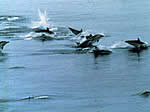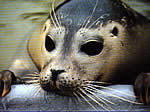|  PCBs
have polluted every place on Earth, and living creatures
are also affected. PCB contamination of sea mammals,
such as porpoises and whales, and seabirds is very serious
since they have very high concentrations of PCBs accumulated
in their bodies. PCBs
have polluted every place on Earth, and living creatures
are also affected. PCB contamination of sea mammals,
such as porpoises and whales, and seabirds is very serious
since they have very high concentrations of PCBs accumulated
in their bodies.
 It
might be hard to believe that PCBs, which are used on
land, are contaminating porpoises and whales that have
no connection to industrial activities. But it is estimated
that about 35% of PCB wastes have accumulated in coastal
sediments and about 60% is dispersed in seawater. This
means that the primary eventual destination of PCBs
is the ocean. It
might be hard to believe that PCBs, which are used on
land, are contaminating porpoises and whales that have
no connection to industrial activities. But it is estimated
that about 35% of PCB wastes have accumulated in coastal
sediments and about 60% is dispersed in seawater. This
means that the primary eventual destination of PCBs
is the ocean.
|
Estimated PCB Loads in the Global Environment
 |
 |
 |
 |
 |
| Environment |
PCB
load (t) |
Percentage
of PCB load |
Persentage
of
world production |
 |
 |
 |
 |
 |
Terrestrial
and coastal
|
Air
|
500
|
0.13
|
|
River and
lake water
|
3,500
|
0.94
|
|
Seawater
|
2,400
|
0.64
|
|
Soil
|
2,400
|
0.64
|
|
Sediment
|
130,000
|
35
|
|
Biota
|
4,300
|
1.1
|
|
Total (A)
|
143,000
|
39
|
|
Open
ocean
|
Air
|
790
|
0.21
|
|
Seawater
|
230,000
|
61
|
|
Sedeiment
|
110
|
0.03
|
|
Biota
|
270
|
0.07
|
|
Total (B)
|
231,000
|
61
|
|
| Total
load in the environment (A+B) |
374,000
|
100 |
31 |
| Degraded
and incinerated |
43,000 |
|
4 |
| Land-stocked* |
783,000 |
|
65 |
World
production
|
1,200,000 |
|
100 |
 |
 |
 |
 |
 |
|
S. Tanabe (1985). J. Oceanogr. Soc. Japan, 41, 358-70.
*Still in use in electrial eqipment and other products, and
deposited in landfills and dump
 Pollution
of the ocean means that plankton and fish are also polluted.
Since PCBs are slow to decompose, they accumulate in the bodies
of ocean dwelling creatures, and particularly in those creatures,
such as porpoises and whales, that eat large amounts of small
creatures, resulting in higher concentrations of PCBs. Mammals
in particular have thick layers of fat and PCBs are easily
absorbed in body fats, so sea mammals have a tendency to high
levels of contamination. Pollution
of the ocean means that plankton and fish are also polluted.
Since PCBs are slow to decompose, they accumulate in the bodies
of ocean dwelling creatures, and particularly in those creatures,
such as porpoises and whales, that eat large amounts of small
creatures, resulting in higher concentrations of PCBs. Mammals
in particular have thick layers of fat and PCBs are easily
absorbed in body fats, so sea mammals have a tendency to high
levels of contamination.
 Moreover,
it is believed that porpoises and whales are more contaminated
than animals on land because of their lower metabolic abilities.
In recent years there have been mass seal deaths, and PCBs
are suspected as one of the causes. One theory is that PCBs
disrupted seals' immune systems, making them vulnerable to
viral infections, leading to mass deaths. Moreover,
it is believed that porpoises and whales are more contaminated
than animals on land because of their lower metabolic abilities.
In recent years there have been mass seal deaths, and PCBs
are suspected as one of the causes. One theory is that PCBs
disrupted seals' immune systems, making them vulnerable to
viral infections, leading to mass deaths.
We should take these phenomena in the natural world as a serious
warning. It will be too late to start taking action after
we find similar phenomena in humans.
Comparison of total PCB concentrations (wet wt.)
of PCBs in cetaceans from various regions
 |
 |
 |
 |
 |
 |
 |
 |
Dall's
porpoise
|
Bering
Sea
|
1985 |
13 |
Dall's
porpoise
|
North-eastern
North Pacific |
1987 |
19 |
Common
dolphin
|
North-eastern
North Pacific |
1987 |
22 |
Harbour
porpoise
|
Hokkaido,
Japan
|
1993 |
8 |
Dall's
porpoise
|
Japan Sea
|
1989 |
34 |
Northern
right whale dolphin
|
Northern
North Pacific
|
1991 |
30 |
Pacific
white-sided dolphin
|
Northern
North Pacific
|
1991 |
27 |
Striped
dolphin
|
off Sanriku,
Japan
|
1992 |
37 |
Fraser's
dolphin
|
off Kii
Peninsula, Japan
|
1991 |
51 |
Hump-backed
dolphin
|
Hong Kong
|
1993-1997 |
31 |
Finless
porpoise
|
Hong Kong
|
1993-1997 |
20 |
Spinner
dolphin
|
Mindanao
Sea, Philippines
|
1996 |
2.5 |
Fraser's
dolphin
|
Mindanao
Sea, Philippines
|
1996 |
6.2 |
Spinner
dolphin
|
Bay of
Bengal, India
|
1990 |
2.2 |
Dall's
porpoise
|
Northern
North Pacific
|
1980-1985 |
8.6 |
Finless
porpoise
|
Seto island
Sea, Japan
|
1985 |
320 |
Baird's
beaked whale
|
Pacific
coast of Japan
|
1985 |
2.3 |
Killer
whale
|
Pacific
coast of Japan
|
1986 |
370 |
Harbour
porpoise
|
Black Sea
|
1993 |
22 |
Striped
dolphin
|
Western
Mediterranean Sea
|
1990 |
390 |
Bottlenose
dolphin
|
Italian
coastal waters
|
1992 |
590 |
Risso's
dolphin
| Italian
coastal waters
|
1992 |
320 |
Common
porpoise
|
Puck Bay,
Baltic Sea
|
1989-1990 |
31 |
Beluga
whale
|
St. Lawrence
river
|
1987-1990 |
160 |
Killer
whale
|
British
Columbia coast
|
1986-1989 |
22 |
False killer
whale
|
British
Columbia coast
|
1987-1989 |
40 |
Risso's
dolphin
|
British
Columbia coast
|
1988 |
1.7 |
Dall's
porpoise
|
British
Columbia coast
|
1987-1988 |
4.5 |
Harbour
porpoise
|
British
Columbia coast
|
1987-1989 |
8.4 |
 |
 |
 |
 |
|
Minh et al., (2000)Water Science and Technology, vol. 42, Nos
7-8, 231-240
Photo:Center for Marine Environmental Studies
(CMES), Ehime University
|
